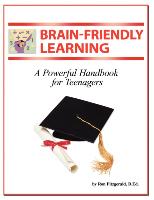Brain-Friendly Learning: A Powerful Handbook for Teenagers
BücherAngebote / Angebote:
The Handbook: This compact handbook is a great resource for any high school or middle school student. It uses recent brain research to help a teenager learn how to use his or her unique brain most effectively in school and then in college or on a carefully selected career path.
Summary of Main Points Explained in the Handbook
1. Using brain-friendly techniques improves learning.
2. LEARNING HOW TO LEARN is an important subject.
3. Brain characteristics vary based on left-right dominance and upper-lower thinking preferences.
4. The left brain favors logic, words, and numbers.
5. The right brain favors randomness and images. (Use drawings in your notes.)
6. Different styles of receiving information include auditory, visual, somatic, and reflective.
7. Use your preferred style for difficult learning, but grow your comfort with other styles also.
8. Graphic organizers can be useful to most learners.
9. The brain tends to remember useful information.
10. Using multiple senses usually results in more learning than using one sense.
11. Discussion with others can aid learning.
12. Using information gives it meaning and helps learning.
13. Teaching others helps you to learn more.
14. Each of us has multiple types of intelligence or thinking techniques, but most of us have intelligence or talent preferences.
15. As with learning styles, use your preferred intelligences but grow others also to gain the most thinking power.
16. Emotional intelligence is especially important to career success.
17. A cause and effect diagram can be a powerful thinking and planning tool. Use it to grow planning power in your pre-frontal lobes.
18. A Brain Preference Test can give you important information on your thinking preferences.
19. Matching your thinking preferences to a career area can help you to enjoy your work.
20. Be conscious of your best attention span (age + 2 minutes to a maximum of 30).
21. Use the beginning-end-middle or B.E.M. rule to improve learning efficiency. Alternate study with short breaks or changed activity.
22. Repetition aids remembering.
23. Experience or doing something with what you have learned aids remembering.
24. Experiencing emotion with learning promotes remembering.
25. Downtime (breaks, rest, or sleep) after learning and then review or using the information
promotes remembering.
The Author: Ron Fitzgerald has over 50 years of experience as a teacher, school superintendent, state director of educational research, and multi-state consultant on brain-friendly learning and quality in the classroom. He is the author of a handbook for teachers entitled SMART TEACHING: USING BRAIN RESEARCH AND DATA TO CONTINUOUSLY IMPROVE LEARNING, published by The American Society for Quality. He maintains a free web site of resources for teachers at www.SuccessInTeaching.info.
Folgt in ca. 15 Arbeitstagen
